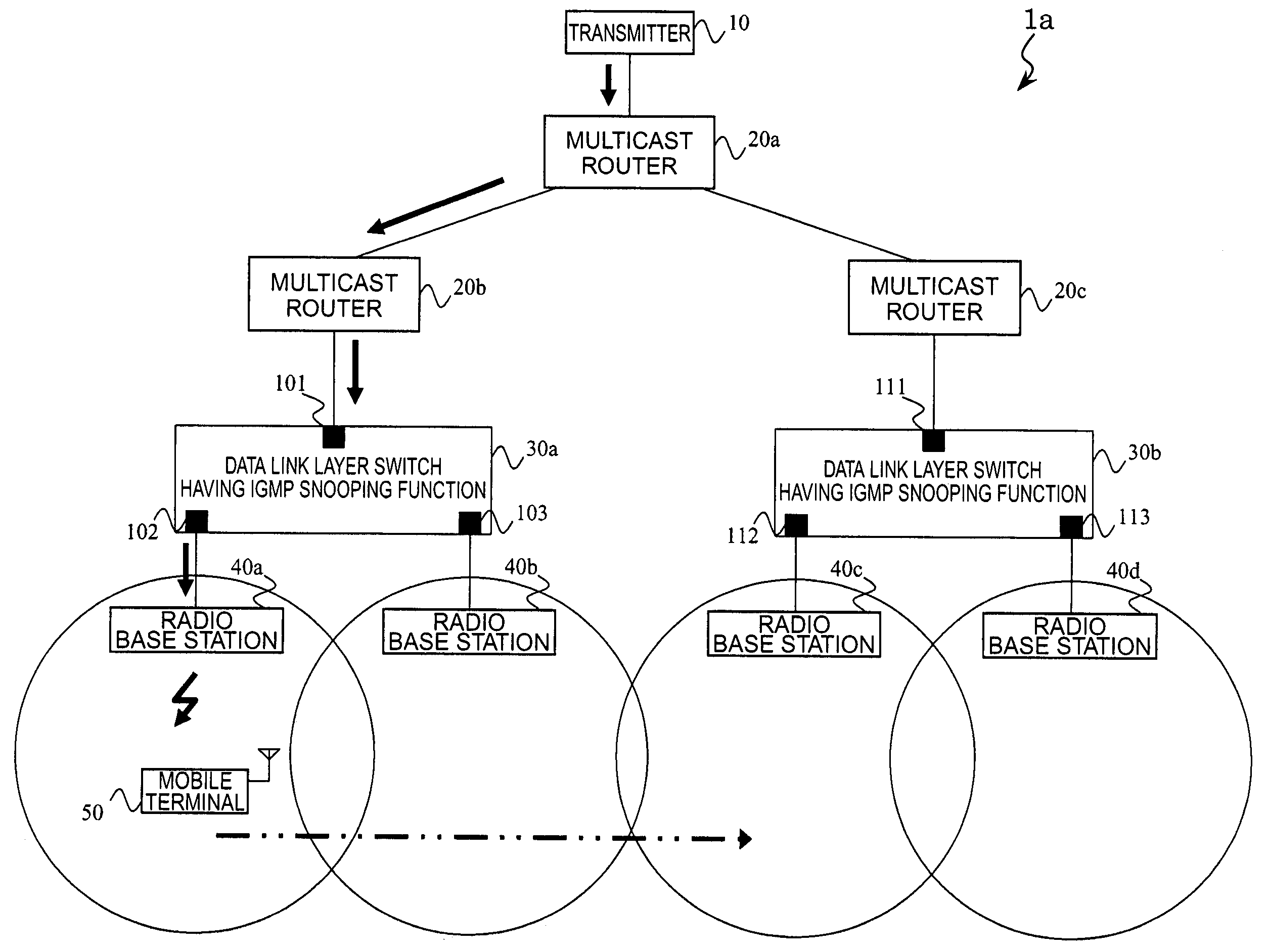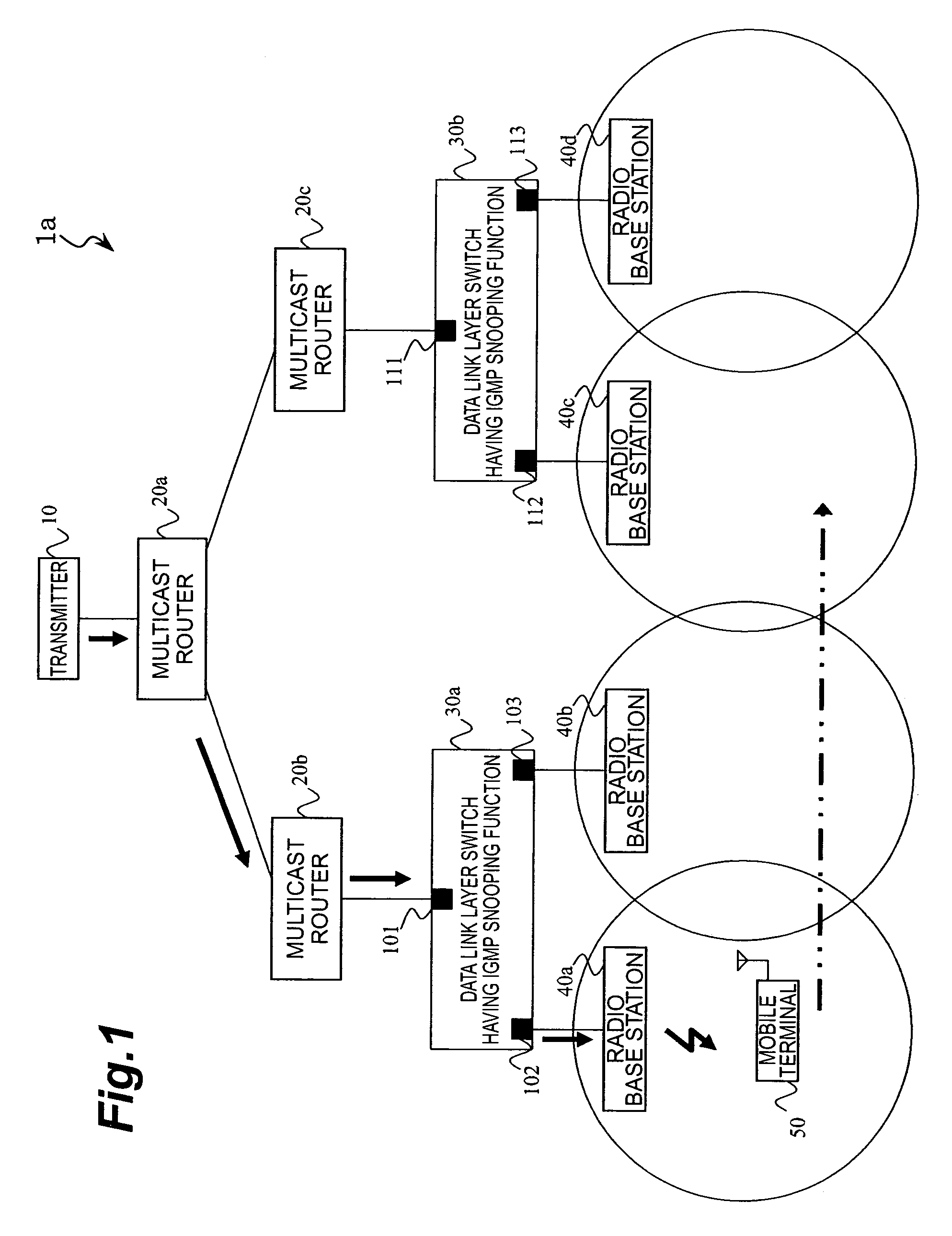Mobile communication system, mobile terminal, and mobile communication method
a mobile communication system and terminal technology, applied in the field of mobile communication systems, mobile terminals, and mobile communication methods, can solve the problems of terminals not being able to join and leave, and the distribution of multicast packets from the previous radio base station cannot be stopped, so as to prevent wasteful use of the band, reduce the delay time, and reduce the delay time.
- Summary
- Abstract
- Description
- Claims
- Application Information
AI Technical Summary
Benefits of technology
Problems solved by technology
Method used
Image
Examples
first embodiment
[0108]FIG. 1 is a conceptual view of a mobile communication system 1a according to a first embodiment of the invention. The mobile communication system 1a includes a transmitter 10 which transmits multicast packets using multicast communication, multicast routers 20a, 20b, and 20c which copy and distribute multicast packets from the transmitter 10, data link layer switches 30a and 30b having an IMGP snooping function for making a copy of a packet distributed from a multicast router and distributing it only to a port which has a receiver downstream thereof, and radio base stations 40a, 40b, 40c, and 40d which transmit a packet distributed from a data link layer switch to a radio network downstream thereof.
[0109]The multicast router 20a is connected to the transmitter 10. The multicast routers 20b and 20c are connected to the multicast router 20a downstream thereof, and the multicast routers are provided in the form of a tree. While the present embodiment shows an example in which mul...
second embodiment
[0140]FIG. 14 is a conceptual view of a mobile communication system 2a according to a second embodiment of the invention. In this embodiment, substitute servers 60a and 60b which transmit a request for withdrawal from a multicast group on behalf of a mobile terminal 50 are provided downstream of multicast routers 20b and 20c. When the substitute server 60a or 60b receives a request for withdrawal from a multicast group from the mobile terminal 50, it transmits a request for withdrawal from the multicast group to the multicast router to which the server itself is connected.
[0141]In FIG. 8 described above, when the multicast router connected to the mobile terminal 50 is switched, the mobile terminal 50 transmits a request for withdrawal from the multicast group directly to the previous multicast router 20b. In the present embodiment, the mobile terminal 50 transmits a request for withdrawal from the multicast group to the substitute server 60a. Upon receipt of the request for withdraw...
third embodiment
[0142]FIG. 15 is a conceptual view of a mobile communication system 3a according to a third embodiment of the invention. While only one data link layer switch is connected downstream of one multicast router in the above description, a plurality of data link layer switches may be connected in the form of a tree as shown in the drawing. Each data link layer switch independently performs processes associated with a multicast distribution management table of itself by examining the path establishing requests and the presence check requests as described above, and the multicast packets can be thus distributed only to paths in which receivers exist.
[0143]As described above, in each of the above embodiments, when the mobile terminal 50 detects that the radio base station connected to the same has been switched, it examines whether the multicast router connected to the same has been also switched. When the connected multicast router has not changed, the mobile terminal 50 sequentially trans...
PUM
 Login to View More
Login to View More Abstract
Description
Claims
Application Information
 Login to View More
Login to View More - R&D
- Intellectual Property
- Life Sciences
- Materials
- Tech Scout
- Unparalleled Data Quality
- Higher Quality Content
- 60% Fewer Hallucinations
Browse by: Latest US Patents, China's latest patents, Technical Efficacy Thesaurus, Application Domain, Technology Topic, Popular Technical Reports.
© 2025 PatSnap. All rights reserved.Legal|Privacy policy|Modern Slavery Act Transparency Statement|Sitemap|About US| Contact US: help@patsnap.com



